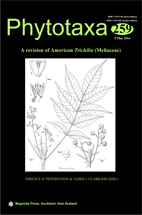Abstract
The internal transcribed spacer (ITS) region of ribosomal DNA (rDNA) was used to investigate phylogenetic relationships in Trichilia (Meliaceae). Analyses focused on the neotropical Trichilia and consisted of 112 accessions (95 neotropical Trichilia, 6 African Trichilia and 11 Meliaceae Outgroups). Bayesian and Parsimony approaches demonstrated that the Cuban species T. havenensis is the earliest diverging lineage in the genus. The African species of Trichilia are nested within the neotropical clade. Section Moschoxylun (primarily Amazonian rainforest species) shows significantly lower levels of sequence divergence than section Trichilia (primarily dry/ seasonally dry forest species). Recently diverged rainforest taxa have been documented in several other Angiosperm families and our results therefore confirm this phenomenon.

